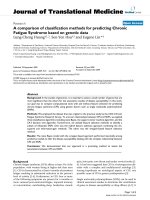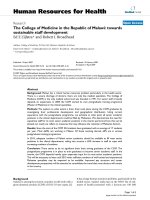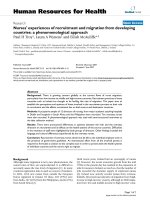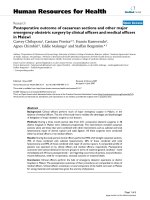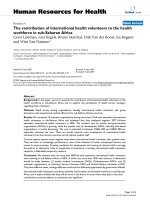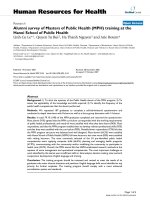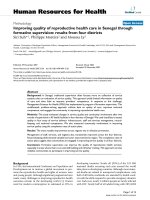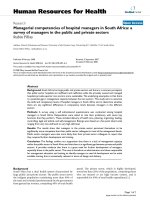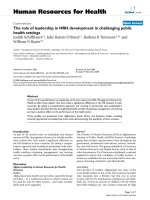Báo cáo sinh học: " Genome comparison of two Coccolithoviruses" doc
Bạn đang xem bản rút gọn của tài liệu. Xem và tải ngay bản đầy đủ của tài liệu tại đây (471.62 KB, 6 trang )
BioMed Central
Page 1 of 6
(page number not for citation purposes)
Virology Journal
Open Access
Research
Genome comparison of two Coccolithoviruses
Michael J Allen
1
, Declan C Schroeder
2
, Andrew Donkin
1
,
Katharine J Crawfurd
1
and William H Wilson*
1
Address:
1
Plymouth Marine Laboratory, Prospect Place, The Hoe, Plymouth, PL1 3DH, UK and
2
Marine Biological Association, Citadel Hill,
Plymouth, PL1 2PB, UK
Email: Michael J Allen - ; Declan C Schroeder - ; Andrew Donkin - ;
Katharine J Crawfurd - ; William H Wilson* -
* Corresponding author
Abstract
Background: The Coccolithoviridae is a recently discovered family of viruses that infect the marine
coccolithophorid Emiliania huxleyi. Following on from the sequencing of the type strain EhV-86, we
have sequenced a second strain, EhV-163.
Results: We have sequenced approximately 80% of the EhV-163 genome, equating to more than
200 full length CDSs. Conserved and variable CDSs and a gene replacement have been identified
in the EhV-86 and EhV-163 genomes.
Conclusion: The sequencing of EhV-163 has provided a wealth of information which will aid the
re-annotating of the EhV-86 genome and identified a gene insertion in EhV-163.
Background
We recently determined the whole genome sequence of
the Coccolithoviridae strain EhV-86, a giant dsDNA algal
virus from the family Phycodnaviridae that infects the
marine coccolithophorid Emiliania huxleyi [1]. Core genes
common to nuclear-cytoplasmic large DNA virus
(NCLDV) genomes were identified and eight of these
genes were used to create a phylogenetic tree in which
EhV-86 was placed at the root of the Phycodnaviridae [2].
Due to the placement of EhV-86 on a branch distinct from
other Phycodnaviridae and the presence of six RNA
polymerase subunits (unique among the Phycodnaviridae)
we suggested this genus would eventually be renamed as
a subfamily of the Phycodnaviridae termed Coccolithoviri-
nae.
Strain EhV-86 was originally isolated, along with many
others, in 1999 from an Emiliania huxleyi bloom in the
English Channel [3,4]. In contrast, EhV-163 was isolated
from the geographically distinct area of Western Norway
during a mesocosm experiment in 2000 [3]. Both virus
genomes were initially estimated to be approximately 410
kbp in size. We have subsequently sequenced the entire
EhV-86 genome and shown it to be 407, 933 base pairs
(bp) [1]. Phylogenetic analysis based on the DNA
polymerase gene has previously shown that EhV-163 is
distinct from all English Channel strains isolated thus far
[3]. In order to gain further insight into both the common
and unique relationship these two viruses have with their
host, Emiliania huxleyi, and their possible placement
within a putative subfamily, we have undertaken to
sequence a second coccolithovirus genome, EhV-163.
Results
The sequencing of EhV-86 was hindered by the highly
repetitive nature of the genome (three different types of
Published: 22 March 2006
Virology Journal2006, 3:15 doi:10.1186/1743-422X-3-15
Received: 25 October 2005
Accepted: 22 March 2006
This article is available from: />© 2006Allen et al; licensee BioMed Central Ltd.
This is an Open Access article distributed under the terms of the Creative Commons Attribution License ( />),
which permits unrestricted use, distribution, and reproduction in any medium, provided the original work is properly cited.
Virology Journal 2006, 3:15 />Page 2 of 6
(page number not for citation purposes)
repeat family were identified [5]), which suggested the
elucidation, in a much smaller scaled project, of a second
closely related strain would be difficult. However, by
using a random shotgun approach at first, followed by a
second directed approach to fill in missing sequence
based on an EhV-86 backbone, we have managed to
sequence approximately 322 kbp of the EhV-163 genome
in 267 contigs, equating to around 80% of the estimated
genome size. This has provided enough genetic informa-
tion to perform an analysis of the two coccolithovirus
genomes. Of the 472 CDSs predicted in the EhV-86
genome [1], from the EhV-163 contigs, full sequence was
obtained for 202 CDSs and partial sequence was obtained
for a further 182 CDSs. Contigs from EhV-163 were typi-
cally between 95–100% identical to EhV-86 sequence
(Additional file 1). Regardless of contig size and content
(intergenic or genic), EhV-163 contigs aligned with perfect
colinearity (except in one case, discussed below) to the
EhV-86 genome sequence.
Highly conserved CDSs
Of the 202 CDSs that had complete sequence, 20 were
identical at DNA level and a further 17 were identical at
the amino acid level (Additional file 1). These 37 con-
served CDSs are distributed throughout the genome; how-
ever there are some that appear to be clustered together in
4 regions. CDSs ehv027 (unknown function), ehv028
(putative ligase) and ehv029 (putative membrane pro-
tein); ehv135 (putative membrane protein) and ehv136
(unknown function); ehv165 (putative membrane pro-
tein), ehv166 (putative RING finger containing protein),
ehv167 (RNA polymerase subunit 10) and ehv168 (puta-
tive membrane protein); and ehv260 (unknown func-
tion), ehv261 (unknown function) and ehv263
Artemis Comparison Tool (ACT) alignment of EhV-86 genomic sequence (Top) against EhV-163 contig DQ127555 (Bottom)Figure 1
Artemis Comparison Tool (ACT) alignment of EhV-86 genomic sequence (Top) against EhV-163 contig DQ127555 (Bottom).
The putative phosphate permease gene, ehv117, of EhV-86 has been replaced by a putative endonuclease, ehv117a, in EhV-163.
Virology Journal 2006, 3:15 />Page 3 of 6
(page number not for citation purposes)
(unknown function) are found in these four clusters. The
high degree of conservation among these 37 CDSs implies
they are under high selection pressure or were recently
acquired by the last common ancestor of EhV-86 and EhV-
163. Since it has been shown previously that RNA
polymerase was present in the ancestral NCLDV prior to
the divergence of the Poxviridae, Iridoviridae, Asfariviridae,
Phycodnaviridae and Mimiviridae families, it is likely that
for ehv167, at least, the high degree of conservation is due
to a high selection pressure [2,5,6]. This also implies that
RNA polymerase function is crucial to the infection strat-
egy of coccolithoviruses, providing further evidence for a
life style distinct from the other previously sequenced Phy-
codnaviridae (PBCV-1 and ESV-1).
Gene replacement
No sequence was obtained for 88 of the 472 CDSs pre-
dicted to be encoded in the EhV-86 genome. The similar
size of the EhV-163 genome in comparison with that of
EhV-86 and the high levels of similarity in other regions
suggests that the majority of these CDSs are likely to be
present. Indeed, a hybridisation of EhV-163 genomic
DNA to the EhV-86 based coccolithovirus microarray has
revealed that of the 425 EhV-86 CDSs probed for, only 28
appear to be absent in EhV-163 (unpublished data). How-
ever, one notable gene deletion in EhV-163 is a putative
phosphate permease found at approximately 115 kb on
the EhV-86 genome (See Figure 1). This region was
sequenced in a 6.9 kbp contig from EhV-163 that con-
tained the full sequence of ehv115, ehv116, ehv118,
ehv119, ehv120, ehv121, ehv122 and ehv123. The 1.6 kb
phosphate permease gene, known as ehv117, is absent
from this contig in EhV-163. This CDS gave no hybridisa-
tion signal in the microarray genomic analysis and all
attempts to amplify ehv117 by PCR from EhV-163 gDNA
have failed (unpublished data). In place of ehv117 in
EhV-163 is a 600 bp region that contains a 75 bp 3' rem-
nant of ehv117 and a 435 bp putative CDS that appears to
encode a 144 amino acid protein which contains a HNH
signature domain, characteristic of a homing endonucle-
ase. The functional relevance of this intriguing gene
replacement is yet to be determined and warrants further
investigation.
Variation in CDSs
The majority of EhV-163 CDSs are predicted to start and
stop at the same locations as their EhV-86 counterparts.
Variation occurs at the DNA and amino acid level but gen-
erally the overall length and structure of the genes is very
similar. However, there are some differences between the
CDSs in the two strains. Changes in DNA sequence can
take a variety of forms: point mutations which may or
may not lead to the introduction/disruption of the start/
stop codon, in-frame insertions/deletions, and insertions/
deletions leading to truncated/extended proteins. Exam-
ples of all these types of changes can be found when com-
paring the sequence from the genomes of EhV-86 and
EhV-163 (Table 1). The majority of coding inserts and
deletions are kept in frame (i.e. occur in multiples of 3
bp). These changes lead to changes in protein structure
Table 1: Examples of genetic changes in the predicted CDSs of EhV-163 in comparison with EhV-86.
CDS Genetic change(s) Consequence
ehv060 3' variable region Truncated protein
ehv100 21 bp deletion 7 amino acid insertion
ehv111 27 bp variable region containing a 3 bp insertion 9 amino acid variable region
ehv118 24 bp and 12 bp insertions 8 and 4 amino acid inserts
ehv128 1 bp insert Truncated protein
ehv142 Numerous point mutations Highly variable protein sequence
ehv146 1 bp insertion Truncated protein
ehv172 12 bp deletion, 1 bp insertion Truncated protein
ehv173 Two 3 bp deletions, 3 bp and 21 bp insertions Variable protein sequence
ehv181 24 bp insertion, 15 bp insertion, point mutation creating stop codon Inserts of 8 and 5 amino acids. Truncated protein.
ehv206 9 bp and 18 bp insertions Inserts of 3 and 6 amino acids
ehv210A Point mutation in stop codon Truncated protein
ehv235 3 bp insertion, 11 bp deletion, numerous small deletions Truncated protein
ehv276 Point mutation creating stop codon Truncated protein
ehv277 Point mutation in stop codon Protein extended
ehv285 1 bp insert Truncated protein
ehv304 14 bp insert Truncated protein
ehv321 16 bp insert Truncated protein
ehv339 Point mutation creating stop codon Truncated protein
ehv341 Point mutation in stop codon Protein extended
ehv359 21 bp deletion 7 amino acid deletion
ehv381 Point mutation in start codon, 1 bp deletion Altered Start of translation
ehv406 Six 1 bp deletions Variable protein sequence
Virology Journal 2006, 3:15 />Page 4 of 6
(page number not for citation purposes)
Clustal W alignment of the EhV-86 and EhV-163 homologs for the CDS ehv142Figure 2
Clustal W alignment of the EhV-86 and EhV-163 homologs for the CDS ehv142. An asterix denotes a conserved base.
Virology Journal 2006, 3:15 />Page 5 of 6
(page number not for citation purposes)
which could account for different phenotypes (such as
host range) to be shown by EhV-163 and EhV-86 [3].
When annotating a genome it is often necessary to predict
where the start of translation codons are. The advantage in
having two related genomes is that you can re-check your
annotation. This is particularly important in the coccol-
ithoviruses since the majority of CDSs have no database
homologues making gene prediction difficult. The vast
majority of CDSs in EhV-86 appear to be very similar to
their EhV-163 equivalents. However, there are some CDSs
that appear to need re-annotating in the light of the
sequence data from EhV-163 (Table 1, Additional file 1).
For example, although the overlapping of CDSs is com-
mon is some virus genomes [7], this is not a common
occurrence in the EhV-86 genome. However, an overlap of
CDSs occurs in EhV-86 with ehv380 and ehv381. This
overlap does not occur in EhV-163, due to a change in the
predicted start of translation methionine codon (ATG to
ATA) and a 1 bp deletion that would otherwise cause a
frameshift. It therefore appears likely that, in EhV-163 at
least, the start of translation occurs from the ATG that is
present 36 bp downstream of current predicted ATG start
codon of ehv381 in EhV-86.
There appears to be a high degree of variation in ehv142
between the two strains. The CDS has approximately 86.9
% identity at the nucleotide level (183 of the 1398 nucle-
otides are different) and 79.1% identity at the amino acid
level (97 of the 465 amino acids are different) (Figure 2).
Most of the variation occurs in the 5' region of the CDS.
BLASTP and PSI-BLAST searches reveal no significant
matches. However, PSI-BLAST searches reveal strong
matches for KELCH-like proteins (e
-50
) after only two
rounds for the EhV-163 version of ehv142. PSI-BLAST
searches using the corresponding EhV-86 CDS reveal no
matches for KELCH-like proteins, suggesting ehv142 may
play a different role in each virus strain. Both EhV-86 and
EhV-163 are capable of infecting many of the same strains
(with varying virulence) [3]. However, there are many
strains of E. huxleyi that are susceptible to infection by
only one or other of the viruses (unpublished data).
Intriguingly, KELCH-like proteins have been identified in
poxviruses and are found to be highly variable [8-10].
Indeed, variation in the KELCH-like proteins of poxvi-
ruses has been shown to account for variation in viru-
lence, host range and reproduction [8,9].
Conclusion
EhV-86 and EhV-163 belong to a unique family of algal
viruses whose genomes contain a high proportion of
genes of unknown function. The sequencing of EhV-163
has provided a wealth of information which will aid the
re-annotating of parts of the EhV-86 genome and identi-
fied an intriguing gene replacement and a highly diver-
gent CDS in the two genomes. Furthermore, the discovery
of highly conserved non-core genes of unknown function
in these strains suggests their importance to these viruses,
adding further credence to the hypothesis that the Cocco-
lithovirus genus has lifestyle distinct from other members
of the Phycodnaviridae.
Methods
Preparation of EhV-163 concentrate
Six 1L cultures of exponentially growing E. huxleyi
CCMP1516, at a cell concentration of 1.2 × 10
6
cells/ml,
were each inoculated with 1 ml of EhV-163 (~2 × 10
5
pfu/
ml). Growth was monitored by cell counts in a Reichert
haemocytometer under a light microscope. Four days
post-inoculation, the decimated cultures were subjected
to a filtration, concentration and purification regime
[3,11].
Virus DNA extraction
DNA was extracted from CsCl-purified EhV-163 by ini-
tially treating the sample with proteinase K (5 mg/ml) in
a lysis buffer containing 20 mM EDTA, pH 8.0 and 0.5%
SDS (w/v) at 65°C for 1 h. 0.1 × volume aliquots of phe-
nol were added to the samples, after which the DNA was
extracted with an equal volume of chloroform:isoamyl
alcohol (24:1). The DNA was precipitated with the addi-
tion of 0.5 × volume 7.5 M ammonium acetate, pH 7.5
and 2.5 × volume absolute ethanol. Virus DNA was stored
in molecular grade water (Sigma) prior to genome
sequencing.
Genome sequencing
Genomic DNA was sheared by sonication, ligated into
pCR-Blunt (Invitrogen) and sequenced using M13 for-
ward and reverse primers. After 2700 reads, the sequence
was assembled into contigs and analysed using SeqMan
(DNAstar). Following alignment to the backbone of EhV-
86, 229 primer pairs were designed, specific to the EhV-
163 gDNA sequence, to attempt to amplify the missing
gaps. The sequence, annealing temperature and genomic
location (in relation to EhV-86) of the primers designed
can be found in the NERC environmental genomic data
catalogue at
under EnvBase acces-
sion number egcat:00010. When a PCR product was
obtained, it was sequenced directly using both primers
and the resulting sequence added to the contig library.
The depth of sequence coverage varied across the genome
due to the random nature of the initial sequencing strat-
egy. Depth of coverage varied from just one sequence read
for some regions to up to18 for others, with an average
coverage of approximately 3. In areas of low coverage,
sequence reads containing ambiguous results were
removed from the analysis. 267 contigs were generated,
covering approximately 80% of the EhV-163 genome.
Publish with Bio Med Central and every
scientist can read your work free of charge
"BioMed Central will be the most significant development for
disseminating the results of biomedical research in our lifetime."
Sir Paul Nurse, Cancer Research UK
Your research papers will be:
available free of charge to the entire biomedical community
peer reviewed and published immediately upon acceptance
cited in PubMed and archived on PubMed Central
yours — you keep the copyright
Submit your manuscript here:
/>BioMedcentral
Virology Journal 2006, 3:15 />Page 6 of 6
(page number not for citation purposes)
These contigs have been submitted to Genbank under the
accession numbers DQ127552-DQ127818. This data is
also available from
, EnvBase
accession number egcat:00010.
Genomic analysis
The Basic Local Alignment Search Tool (BLAST) finds
regions of local similarity between sequences by compar-
ing nucleotide or protein sequences to sequence databases
and calculating the statistical significance of matches. Pro-
tein-protein BLAST (BLAST-P) and Position-specific iter-
ated BLAST (PSI-BLAST) were performed on CDSs of
interest online at />.
Artemis Comparison Tool (ACT) (http://
www.sanger.ac.uk/Software/ACT/) was used to compare
the EhV-163 contigs against the EhV-86 genome.
Competing interests
The author(s) declare that they have no competing inter-
ests.
Authors' contributions
MJA helped coordinate the study, carried out the molecu-
lar genetic studies, sequence alignment and drafted the
manuscript. DSCH prepared the EhV-163 DNA for the
construction of the shotgun library, helped coordinate the
study and draft the manuscript. AD and DSCH con-
structed the EhV-163 clone library. AD screened the
library. AD and KJC performed the sequencing and partic-
ipated in the sequence alignment. WHW conceived,
designed and coordinated the study and helped to draft
the manuscript. All authors read and approved the final
manuscript.
Additional material
Acknowledgements
This research was supported by grants awarded to WHW from the Natural
Environment Research Council (NERC) Environmental Genomics thematic
program (ref. NE/A509332/1) and from Marine Genomics Europe, through
framework programme FP6 of the European Commission. DCS is a Marine
Biological Association of the UK (MBA) Research Fellow funded by grant in
aid from the NERC. WHW is supported through the NERC-funded core
strategic research programme of the Plymouth Marine Laboratory. We
would like to acknowledge support from NERC Environmental Bioinfor-
matics Centre, Centre for Ecology and Hydrology, Oxford for help with
data storage and administration.
References
1. Wilson WH, Schroeder DC, Allen MJ, Holden MTG, Parkhill J, Barrell
BG, Churcher C, Hamlin N, Mungall K, Norbertczak H, Quail MA,
Price C, Rabbinowitsch E, Walker D, Craigon M, Roy D, Ghazal P:
Complete Genome Sequence and Lytic Phase Transcription
Profile of a Coccolithovirus. Science 2005,
309(5737):1090-1092.
2. Allen MJ, Schroeder DC, Holden MT, Wilson WH: Evolutionary
History of the Coccolithoviridae. Mol Biol Evol 2006,
23(1):86-92.
3. Schroeder DC, Oke J, Malin G, Wilson WH: Coccolithovirus (Phy-
codnaviridae): Characterisation of a new large dsDNA algal
virus that infects Emiliania huxleyi. Arch Virol 2002,
147(9):1685-1698.
4. Wilson WH, Tarran GA, Schroeder D, Cox M, Oke J, Malin G: Iso-
lation of viruses responsible for the demise of an Emiliania
huxleyi bloom in the English Channel. J Mar Biol Ass UK 2002,
82:369-377.
5. Allen MJ, Schroeder DC, Wilson WH: Preliminary characterisa-
tion of repeat families in the genome of EhV-86, a giant algal
virus that infects the marine microalga Emiliania huxleyi.
Arch Virol 2006, 151:525–535.
6. Iyer LM, Aravind L, Koonin EV: Common Origin of Four Diverse
Families of Large Eukaryotic DNA Viruses. J Virol 2001,
75(23):11720-11734.
7. Firth AE, Brown CM: Detecting overlapping coding sequences
with pairwise alignments. Bioinformatics 2005, 21(3):282-292.
8. Pires de Miranda M, Reading PC, Tscharke DC, Murphy BJ, Smith GL:
The vaccinia virus kelch-like protein C2L affects calcium-
independent adhesion to the extracellular matrix and
inflammation in a murine intradermal model. J Gen Virol 2003,
84(Pt 9):2459-2471.
9. Kochneva G, Kolosova I, Maksyutova T, Ryabchikova E, Shchelkunov
S: Effects of deletions of kelch-like genes on cowpox virus bio-
logical properties. Arch Virol 2005.
10. Tulman ER, Afonso CL, Lu Z, Zsak L, Sur JH, Sandybaev NT, Kerem-
bekova UZ, Zaitsev VL, Kutish GF, Rock DL: The genomes of
sheeppox and goatpox viruses. J Virol 2002, 76(12):6054-6061.
11. Schroeder DC, Oke J, Hall M, Malin G, Wilson WH: Virus Succes-
sion Observed during an Emiliania huxleyi Bloom. Appl Envi-
ron Microbiol 2003, 69(5):2484-2490.
Additional File 1
Click here for file
[ />422X-3-15-S1.doc]
